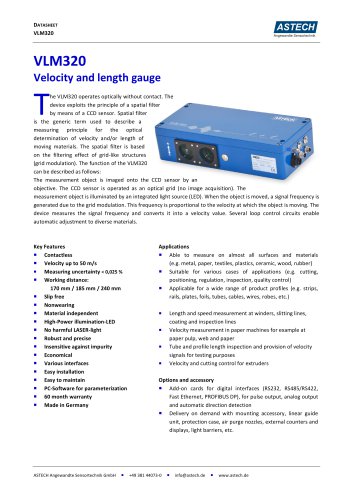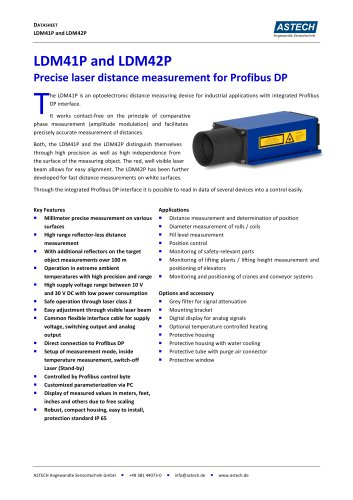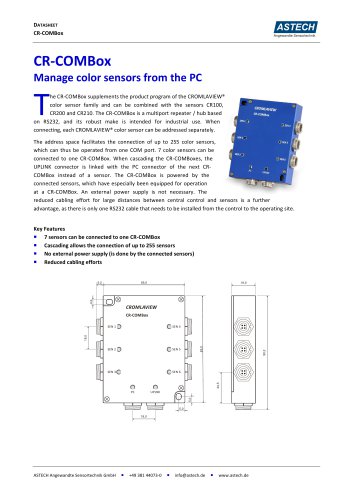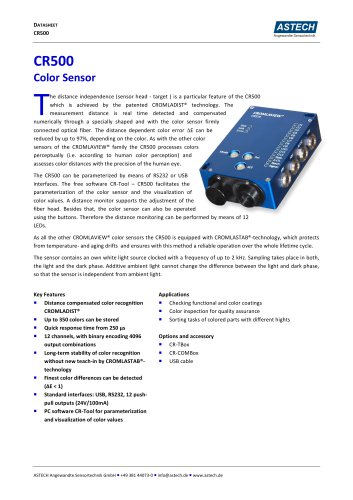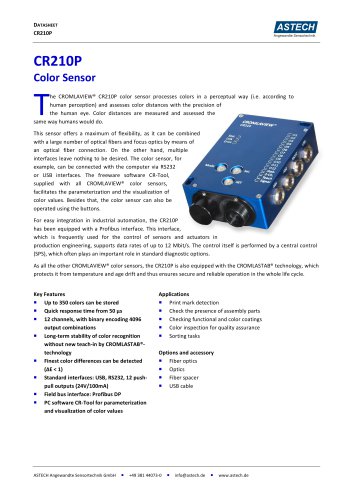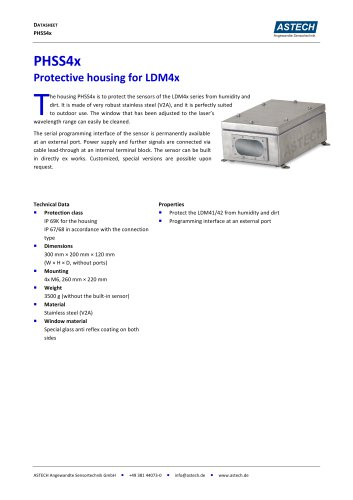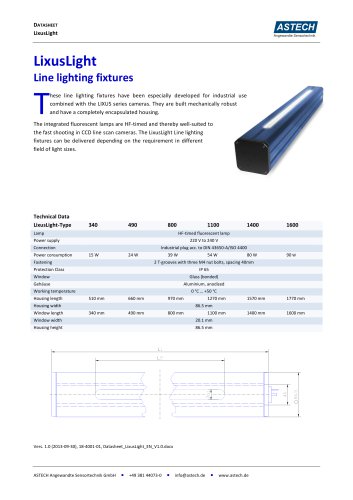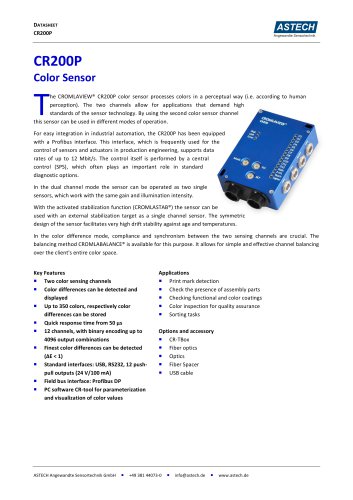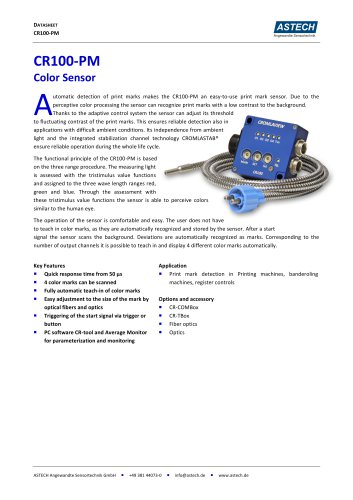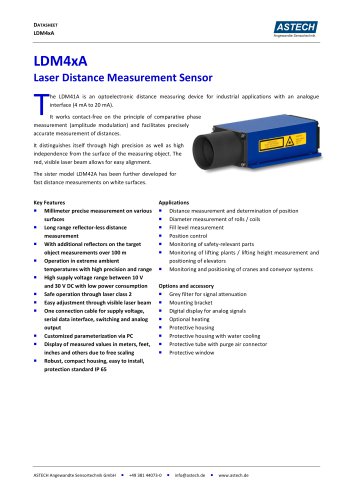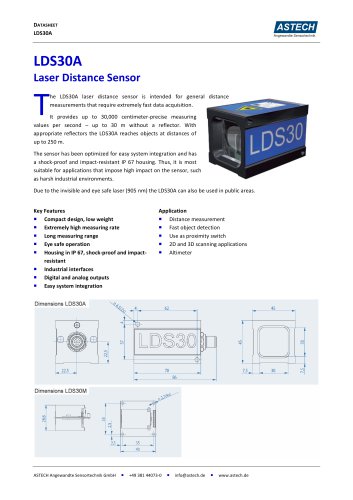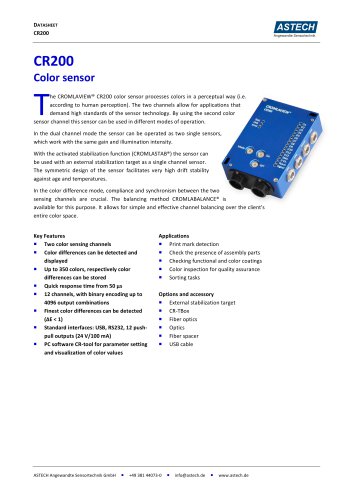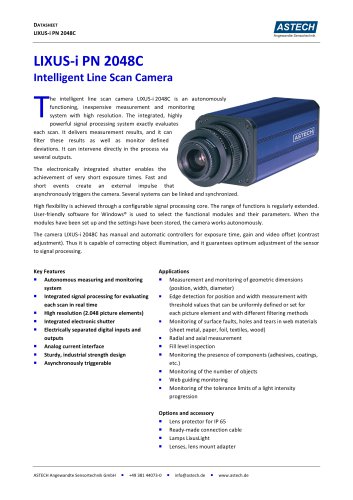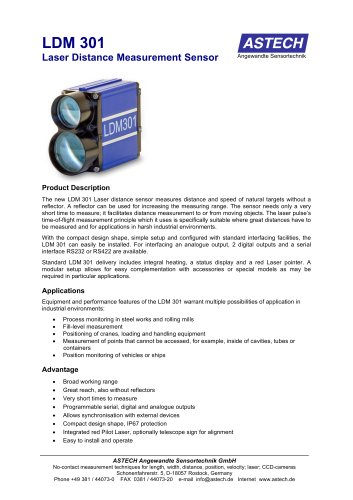 Website:
ASTECH Angewandte Sensortechnik GmbH
Website:
ASTECH Angewandte Sensortechnik GmbH
Catalog excerpts

VLM 320 Series Angewandte Sensortechnik Velocity and length sensor Functional Description The VLM 320 operates optically without contact, and implements the principle of the spatial filter by means of the use of a CCD sensor. Spatial filter is the generic term used to describe a measuring principle for the non-contact determination of the velocity and length of moving materials. The spatial filter is based on the filtering effect of grid-like structures (grid modulation). The function of the VLM 320 can be described as follows: The object to be measured is reproduced through the objective onto the CCD sensor. The CCD sensor is operated as an optical grid (no image pickup). The object to be measured is illuminated by an integrated light source (LED). External light disruptions are effectively suppressed with this method. When the object is moved, a signal frequency is generated due to grid modulation. This frequency is proportional to the velocity at which the object is moving. The device measures the signal frequency and converts it to a velocity value. There are several control circuits that enable automatic adjustment to the most varied of materials (material surface structure and brightness). Applications Suitable for nearly all materials, such as metal, paper, textiles, plastics, rubber, ceramics and timber Suitable for a wide range of products, including strips, rails, plates, foils, tubes, profiles, cables, wires, ropes, etc. Caters for various processes such as cutting, positioning, regulation, inspection, quality control Examples: Length and speed measurement at winders, slitting lines, coating and inspection lines; velocity measurement in paper machines for example at paper pulp, web and paper; tube and profile length inspection and provision of velocity signals for testing purposes; velocity regulation and cutting control for extruders Advantages The semiconductor chip (CCD) is used as a reference: greatest proven long-term stability in the market, excellent short-term stability Measurements can be taken on virtually all surfaces, from high-gloss to matte black, as the device adjusts itself automatically to the task. Even surfaces that could not be measured reliable with any optical measuring equipment can now be measured! Accurate measurements, even if the window is dusty, as the reference is well protected inside the device Compact design, best interface flexibility in the market, including all conventional solutions from analog output to Profibus; high-accuracy pulse output with 5 ns resolution as standard Input for change to standby mode Output for hardware error and standstill/status Safe operation (white LED light source) Easy firmware update/upgrade via PC Modular design: easy maintenance, new assemblies can be used for repair or upgrade older units; light sources and interface boards can be replaced by the customer itself Hardware, lighting and temperature self-diagnosis (error codes and output) All gauges have internal length calculation, sliding average, synchronous-, clock- and date functionality Direct connection of two light barriers possible High interference immunity thanks to 100% potential isolation and sophisticated ESD and EMC protection Replacing of the LED and interface cards is easy for the customer Long service life, making the VLM 320 excellent value for money High quality standard, made in Germany; with 36months warranty ASTECH Angewandte Sensortechnik GmbH Non-contact measuring technology for length, width, distance, position, velocity, laser and CCD cameras CTG Center for Technology and Trade, Schonenfahrerstr. 5, D-18057 Rostock, Germany Telephone +49 (0)381 / 44073-0 fax +49 (0)381 / 44073-20 e-mail info@astech.de Internet www.astech.de
Open the catalog to page 1
VLM 320 Series Angewandte Sensortechnik Velocity and length sensor Technical Data VLM 320 A Working distance and range Extended working range Measuring range in extended working range Max. Acceleration = Ki * v² Measuring uncertainty 5) 1) ) Reproducibility 1 Averaging-/Update-Time Length measuring range Detector / principle Illumination Programming interface 3) 3) Opto-isolated outputs Function Frequency for pulse output Type / max. output current Opto-isolated inputs 3) Function Voltage level Input current Power supply Power consumption Temperature range Protection class Weight 2) EMC 4)...
Open the catalog to page 2All ASTECH Angewandte Sensortechnik GmbH catalogs and technical brochures
-
LDS10A
2 Pages
-
CROMLAVIEW® CR10
1 Pages
-
VLM500-DG
24 Pages
-
LDM41P and LDM42P
2 Pages
-
LDM41E and LDM42E
2 Pages
-
LDM41A and LDM42A
2 Pages
-
CR-TBox
2 Pages
-
CR-COMBox
2 Pages
-
CR500
2 Pages
-
CR50-FO
2 Pages
-
CR210P
2 Pages
-
LDS30A
2 Pages
-
PHSS30x (LDM)
2 Pages
-
PHSS4x (LDM)
2 Pages
-
PHSS4x-W (LDM)
2 Pages
-
LixusLight
1 Pages
-
CR210E
2 Pages
-
CR200P
2 Pages
-
CR200E
2 Pages
-
CR100-PM
2 Pages
-
CROMLAVIEW® CR100 DataSheet
2 Pages
-
LDM 41/42 P
2 Pages
-
LDM41 A Datasheet
2 Pages
-
LDM51A LUMOS Datasheet
2 Pages
-
LDS30 Datasheet
2 Pages
-
FOD-M4.0-1100
4 Pages
-
LIXUS-i PN
2 Pages
-
LDM302A
2 Pages
-
CROMLAVIEW® CR50 / CR50FO Manual
12 Pages
-
LDM301A Datasheet
2 Pages
-
CROMLAVIEW® - Product Catalogue
19 Pages

